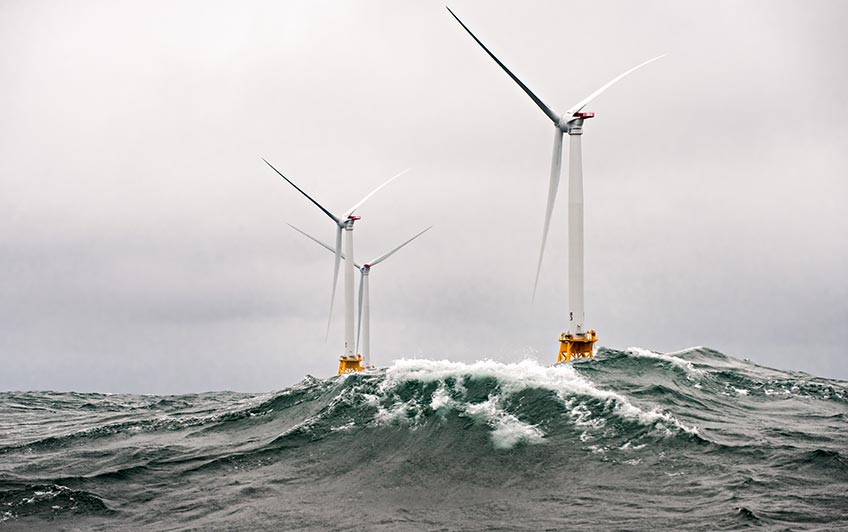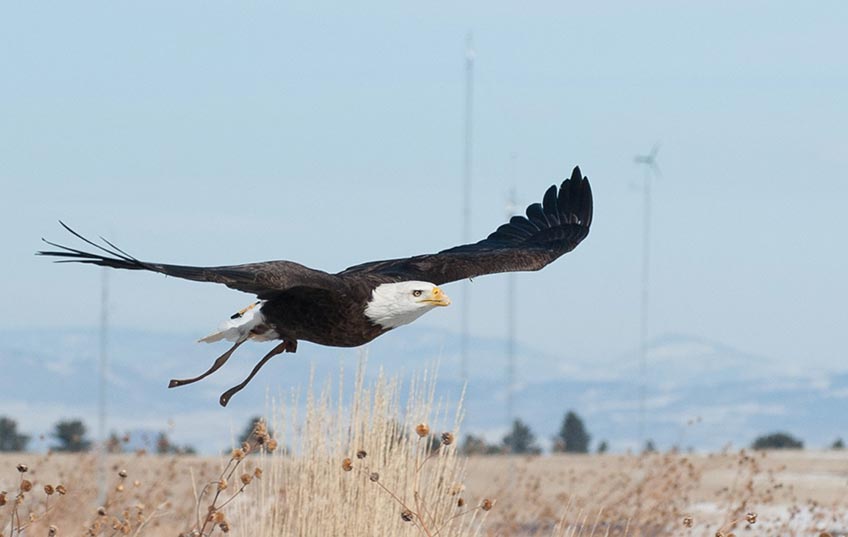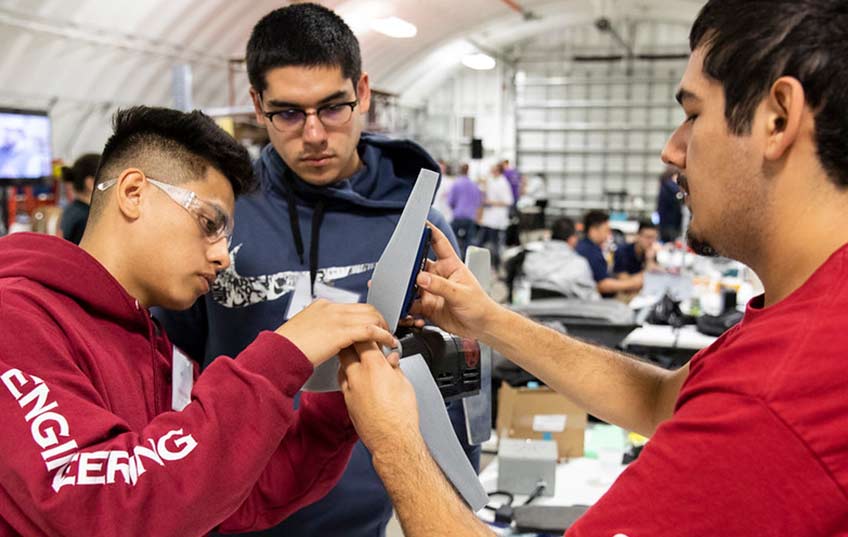On with the Wind
NREL’s Top Wind 2019 Program Accomplishments Fill the Sails of Success

Wind turbines with social skills. Potato guns that help researchers better understand wind-wildlife impacts. A fast-growing and long-lasting demand for skilled wind workers. Whatever the story, 2019 saw gale-force developments in wind energy research at NREL, and these currents show no signs of slowing down.
1. NREL Publishes Science Journal Article Posing Three Grand Challenges to Wind Energy Potential
NREL wind energy researchers were among a team of authors inviting the scientific community to address three “grand challenges” that will drive the innovation needed for wind to become one of the world’s primary sources of low-cost electricity generation. Published in the journal Science, this call to action emphasized the need for interdisciplinary collaboration to meet the challenges and embrace the opportunities of wind energy advancement.
2. National Wind Technology Center Campus Gets a New Name
In 2019, DOE officially changed the name of the National Wind Technology Center campus to the Flatirons Campus in recognition of the facility’s transition from a single-program wind research site to a research campus supporting the needs of multiple programs. Still home to the National Wind Technology Center, NREL’s Flatirons Campus will offer the expanded facilities and infrastructure researchers need to validate multiple technologies at scale (10–20 megawatts) and achieve an integrated energy system that can meet the complex energy challenges of the future. As part of this expansion, construction began on a 115-kilovolt transmission line between a new Flatirons Campus substation and an Xcel Energy substation one mile away. NREL also set plans in motion for a new 19.9-megawatt-capacity Controllable Grid Interface, which will work in tandem with the existing Controllable Grid Interface. These upgrades will enable the energy systems of the future.
3. Software Visualizes Real-Time Wind Power Forecasts
As wind energy becomes more common, power grid operators need tools that allow them to quickly forecast wind power availability. WindView, an open source software developed by NREL, Argonne National Laboratory, and the University of Texas at Dallas, meets this need by visualizing wind power forecasts—allowing operators to make faster, more intuitive decisions about power generation.
By making variable wind resources easier to track, WindView can contribute to further deployment of wind energy in the United States.
4. Wind Turbine Control Strategies Increase Power Production and Revenue Potential
In May 2019, NREL released an enhanced version of its FLOw Redirection and Induction in Steady State (FLORIS) software, which helps wind plant operators optimize turbine interactions. Accuracy and usability improvements include a curled wake modeling function that enables users to model wake steering using counter-rotating vortices, which will be essential to unlocking the full potential of wake steering. To validate the predictions made by the latest version of FLORIS, NREL engineers conducted a field study of wake steering in a realistic environment and found that wake steering controls successfully increased energy capture at downstream turbines in accordance with FLORIS predictions.
Senior Researcher Jennifer King and her team are also developing control strategies that enable wind turbines to “talk” to each other and respond quickly to changes in wind direction—an operating method known as collective consensus control.
These NREL-developed wake steering and wind farm control strategies have the potential to significantly increase annual energy production on wind farms by 1% to 2% depending on plant size and design, increasing profits and reducing plant maintenance costs.
5. NREL Simulation Sets the Benchmark for Next-Generation Supercomputing
Wind plant-level inefficiencies—resulting from variable terrain, unique atmospheric flow phenomena, and the complex flow interactions that occur on large wind farms—still present a challenge to wide-scale wind power deployment.
To address this challenge, NREL researchers, in collaboration with ExaWind, performed the first-ever full-physics simulation of a wind turbine in turbulent atmospheric flow—representing a major step toward the goal of creating a predictive wind energy simulation capability that runs on an exascale-class computer by 2022.
A fully blade-resolved model of an entire wind plant is beyond the capabilities of even today’s fastest, computers, but this simulation capability establishes a key baseline for future model improvements and provides a clearer path to optimizing wind plant efficiency.
6. NREL Facilities and Staff Spearhead Early-Stage Wind-Wildlife Impact Minimization Research
NREL’s Flatirons Campus has become a hotbed of technological innovation for minimizing impacts to wildlife from wind energy. Four separate research projects with the Pacific Northwest National Laboratory, Oregon State University, and the United States Geological Survey validated solutions to monitor, detect, and deter wildlife from approaching wind turbines.
Whether protecting eagles with potato cannons, deterring bats with ultrasound and ultraviolet light, or detecting the presence of both with thermal imaging software, NREL’s staff are helping develop cost-effective ways for wind farms and wildlife to share the skies with minimal conflict.

7. Offshore Wind Market Report Projects Accelerated Growth
The global offshore wind industry installed a record 4,652 megawatts of offshore wind capacity in 2018, and growth forecasts indicate 11-16 gigawatts of offshore wind energy capacity additions in the United States by 2030. That’s the exciting news from the 2018 Offshore Market Technologies Market Report, released in August, which provides unbiased data and analysis about the offshore wind market, technology, and cost trends.
Funded by the Department of Energy’s Wind Energy Technologies Office and written by NREL and DOE researchers, the report provides offshore wind policymakers, regulators, developers, researchers, engineers, financiers, supply chain participants, and other stakeholders with up-to-date quantitative information about the offshore wind market, technology, and cost trends in the United States and worldwide.
8. NREL Helps Prepare Workforce for Energy Needs of Tomorrow
With wind energy technician being dubbed one of the fastest-growing occupations in the United States, NREL is rising to meet this growing workforce demand through hands-on learning opportunities and in-depth analysis.
The biennial U.S. Department of Energy Collegiate Wind Competition, which NREL administers, helps participating university students gain real-world technology experience and networking opportunities, preparing them to enter the wind energy workforce.
Written by researchers from NREL and the Center for the New Energy Economy, The Wind Energy Workforce in the United States: Training, Hiring, and Future Needs assesses the national wind energy workforce, industry hiring needs, educational programs, and gaps in the workforce and path to employment. Economic Impacts from Wind Energy in Colorado—Case Study: Rush Creek Wind Farm, written by researchers from NREL and Colorado State University, highlights the economic impacts of wind energy development in rural Colorado.

As wind becomes an increasingly important source of power, NREL wind energy researchers will draw on their expertise and creativity to help meet new challenges to wind plant design and operation. And as we breeze into 2020, NREL will continue to foster the innovation needed to create a sustainably powered future.
Last Updated May 28, 2025
